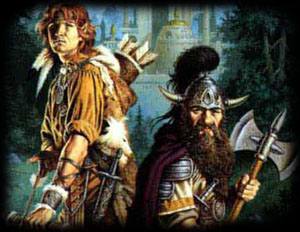
|
Back to the Overview: New Worlds |

|
Back to the Overview: New Worlds |
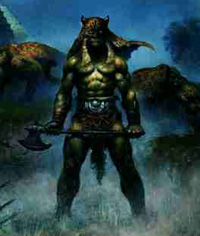 The Trolahk
The Trolahk
The Trolahk are a powerful, warrior race that are creatures of size and strength. They hold to an odd sense of honor in comparison to human counterparts. They believe that it is better to die than be defeated and death is not feared unless accompanied by dishonor. Though honor is something only a Trolahk could define or understand in a reasonable fashion. While powerful, the Trolahk lack any beauty except to those who can find artistry in their dark orange rock-like skin, large jaws with dagger sized fangs, powerful muscles and legs (even on the females), and three toe feet that look more like large skinless bones than anything natural. Trolahk stand on average seven feet, while a large Trolahk could be eight or nine feet tall. They are known to have hair that is long and braided and starts high on the forehead, being pulled back so not to obstruct combat. Not very intelligent, most of a Trolahk's wisdom stems from instinct and at one time it was believed that the Trolahk came from a mating with a mighty human and a rock troll. This last is pure speculation as the Trolahk have a tendency to despise other races, having only some affinity to the Centaur for reasons unknown. |
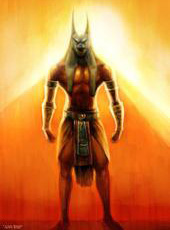 The Nykan
The Nykan
Crossing the southern mountain range and spanning southward across the arid and sandy divide that seperates the Nordenlands from the Sudenlands, lies the lands where a race with elven and jackal like characteristics makes their home; the Nykan. Nykos or Nykan, having their name derived from the Sudenese tongue meaning the -true ones-, are a distant cousin to their northern counterparts, the Lykan. Even though a Nykos and a Lykos share elven and canine characteristics, the Nykos differ greatly enough to deny any kin with the Lykos which lends them proudly as a race unto their own. Nykan are a nomadic race yet still populate themselves in almost all villages and towns of the Sudenlands. To call their wanderings random, however, would show a profound misunderstanding for this race. Having spent generations of adapting to the harsh desert conditions have made them clear masters of the region that they inhabit. No one passes through the desert or the mountain range that they inhabit without their knowledge -- and, therefore, their leave. Nykan are a lithe and muscular people having sleek fur covered bodies and elongated rigid ears that flow seamlessly upwards to a point several inches above the head. Their faces are clearly jackal in appearance with pronounced snouts, a flat dog-like nose and sharp canine teeth. The Nykan who have black, brown and golden shades of fur appear to have the same darkened colored eyes while those who have the lighter shades of sleek fur tend towards lighter colored eyes of blues and greens. All Nykan have the same narrowed pupils, however, like their jackal ancestors. An unusual fact that most people notice about a Nykos is the sweet musky scent that surrounds them yet very few find unpleasant. An average adult Nykos stands around 5 feet 11 inches tall and weighs around 170 pounds. They reach maturity at the age of 15 and have an average life span of 70 years. While a Nykos is more jackal like in appearance with some scavenging tendencies, having the prowess to utilize the sweltering barren lands around them for survival, its the elven blood that is more pronounced in this race. Most Nykan are endowed with intelligence and wit and also show the ability to tap into the flow of magic and craft it to their own uses. They are a social people that get along well with most of the other races in the south but are very leery of strangers of the north, almost taking the meaning of their name -true ones- to a level of rightful dominance. |
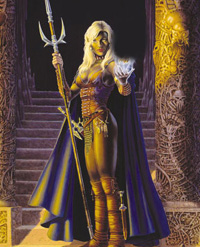 The Malor
The Malor
Scribed in the ancient tomes of elven history, is a story almost lost to time for the short lived about a faction of elves whom were thought to have become corrupt in mind and magic. Rumors of greed and power were whispered behind their backs as they were witnessed using their magic in unusual and even destructive ways. This faction of elves, given the name of Malor or -turned ones-, maintained that they were merely misunderstood. As they continued their deeds, unease began to spread through the elven nation and it was feared that the Malor's "forsaken way" and disregard for their own impact on Ateraan would spread to the younger generations. The Council of Elders reacted and banished the Malor from elven lands. Persecuted for their beliefs, whether founded or not, this small group accepted their fate, severed all ties to their once people and journeyed to the Sudenlands. Filled with animosity for their northern kin, the Malor nonetheless settled into the desert region with conviction and began shaping a new life for themselves as a separate people. Cut off from the north and their accustomed way of life, desert living was difficult for the Malor and many perished that first year in the arid wastelands. Despite no knowledge of desert living, the Malor were still bound and determined to succeed in their new home and slowly began the process that has evolved them into the strong race the people of Ateraan see today. As the southern lands have become more temperate over the centuries their struggle has lessened but the fierce desert has left its mark on the Malor for all time. Ironically, through time the magical abilities of the Malor lessened as their fight for survival in a harsh new land were replaced with more physical attributes. They became slightly shorter and heavier muscled and their skin through constant exposure to the sun, became darker and heartier until all Malor had a duskier complexion. While the Malor still retain the same elongated ears as their northern kin, they now resemble their northern ancestors little. All Malor have darker skin tones, darker shades of hair in blacks and browns with eyes that are just as dark. An average Malor standing at 5 ft 9 inches will reach adulthood at about 80 years of age and weigh around 155 pounds. The normal life expectancy of this race is 400 years. The Malor's relations with the Elves have remained hostile throughout the years, as the old wounds run deep. The Malor generally dislike Nymphs as they remind them of their own magical abilities that have grown weaker over time. Nykan and Malor have often held alliances over the years as even the most independent of races are sometimes in need of aid. Battles have erupted between the Trolahks and Malor in the past, though with each generation of the shorter lived Trolahks the conflict between them has lessened. The Malor thrived through the harshest of times and soon established a way of life. Their social structure became predominantly tribal in nature with small familial groups dominating the culture. Each tribe seemed to specialize in a different skill such as hunters, protectors, cloth makers or gatherers and would identify itself with a unique marking, either by a body inking or a piece of jewelry to reflect that. Although not exactly warlike, skirmishes often erupted with the other races while vying for waterholes or better hunting grounds. Each tribe working together led to their prosperity but it soon became apparent that the other people of the region were to treat the Malor with trepidation and caution. |
 The Dwarves
The Dwarves
Originally in the myth of their creation, the Sons of Stone or dwarves as the other races refer to them as, are said to not have been born but rather spawned from the slivers of metals which fell from the Mighty Forger's hammer. Crafted from the metals deep within the mountains of the North, legend maintains that the dwarves were charged by their maker to tend and protect the Great Fires that boil in the belly of Ateraan. Whether this is true or not, most dwarves hold firm to this belief and other races are wary to discount it when looking upon their elaborate mountain mining systems, vast delved homes and halls, wondrous citadels and their mastery in the arts of mining and forgecraft. The Dwarven nation, with its own king that rules from the capitol Jemeleon, is located in the Northern Mountains where most dwarves live in underground communities excavated by their workers. They are master blacksmiths and craftsmen and use their metals and crafted goods to trade for food with surface races, most often gnomes whom they share a kinship with. Dwarven hunting parties sometimes venture forth from their caverns to hunt for meat, but the only agriculture they practice is fungus gardening. Dwarves are well known for their love of precious metals and jewels. Most will go to great lengths (contingent on their personal morals) to acquire such items and will be hard pressed to give them up. Apart from their weakness for wealth, however, Dwarves are a most noble race. To wield a blade in defense of clan or nation is the highest form of honor for a dwarf, to die while defending such makes one a legend to be carved in stone. Dwarves reach adulthood at age 40 and the average life expectancy for this hearty and strong race is around 300 years. Dwarves are short, strong muscled, stocky humanoids. On average they stand around 4 feet 6 inches tall and average a weight of 180 pounds. Male dwarves sport beards upon maturity and keep them well groomed and trimmed but never shaved. It is not uncommon for a female dwarf to have beards of their own but many do not either from genetics or preference. Hair, eye and skin tones are comparable to that of humans but dwarves tend to have thicker, coarser hair. Both male and female dwarves are known for their feats of strength and hearty constitutions. Avid brewers of fine strong ale, they are far better at stomaching their own brew than most races. Their solid, strong bodies make them very stable, but also not quick on their own feet. Dwarves use their powerful, stocky bodies to their advantage in battle often using it to slam into their foes. While attractive to each other, they're not found physically appealing to others not of their own kind. Dwarves are liked by warriors of most races, being known for their courage and skill on field of battle. In that regard they personally find a stronger affinity with honorable lykos and trolahks, and consider many of them good brothers in arms. Being that gnomes are of a smaller stature and have a proclivity to live underground, dwarves view them as their smaller cousin race even if their quick demeanor can sometimes vex even the most steadfast of dwarves. Dwarves are generally distrustful of the more magical races, not having much magical aptitude of their own. Having healthy appetites of all kinds, both genders are known to mate with other races. Dwarves can be seen in any form of society on Ateraan but most are witnessed as fighters for their fierce loyalty, expert swordmanship and unsurpassed bravery. Dwarves also make fine merchants as they tend to master the forge quicker and have a healthy knowledge of ores and gems. Statesman and politics are usually rare, for dwarves are often gruff and practical and prefer a straight forward brute force approach to problems over subtlety or stealth. Most dwarves have a healthy respect or sometimes even fear of magic. The race produces very few wizards; clerical magic is more common. |
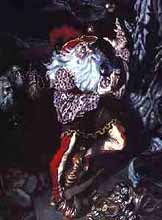 The Gnomes
The Gnomes
Having originated in the subterranean labyrinths of Ateraan, gnomes have thrived in their bustling underground cities and cave-like dwellings. Because of the necessity to maintain their underground lifestyles, gnomes have become masters at land moving and shaping which only bears proof when looking upon their concise and intricate systems of cites and burrowed neighborhoods. However, not all gnomes dwell underground. Driven by their natural curiosity, through the course of time many gnomes have ventured out of their underground dwellings and have opted to build towns on the surface. Surface gnomes prefer to live near natural sources of energy (i.e., waterfalls, rivers, volcanoes, and natural springs). They also take advantage of other natural occurrences such as sunlight, heat, cold, forests and fuels in many ingenious ways. Gnomes are a small and wiry race who are the ancestral cousins of Dwarves and about twice as mischievous. The average gnome is about 3 1/2 feet tall and weighs an average of 60 lbs. Their average life expectancy is 200 years and reach adulthood at 35. Most gnomes have common characteristics of large or elongated noses and large dark eyes. The beards on the males can vary but they tend to have shorter beards than dwarves. Their large eyes are suited for keen sight in the dark and they are very sensitive to light. Generations of gnomes that have lived above ground tend to see better in daylight, but their vision in the day is still not as good as other races that have primarily lived above ground. It is rare for gnomes to have anything but darker colored eyes, and their hair color can vary between darker shades of brown, black and red. They are intelligent and quick, though not as naturally predisposed to be excellent fighters being weaker and less agile then some races. Gnomes are quick to learn the magical arts and gnomish children are almost always taught to summon the famous magical horns of the race. Gnomes have strong inclinations in the way of mechanics, kinetics and machines. Most of the machinery that has advanced on Ateraan can be attributed to their inventions. Often times a traveler will know they're coming upon a gnome community just by the bizarre and bold land shapes they see built by the gnome master crafters. Gnomes are a trusting and friendly race and are very curious and inquisitive about others. It is often said that gnomes are too trusting and historians have blamed this tendency for instances in which groups of gnomes have been taken advantage of in the past. While gnomes are naturally open to most races, this feeling is not always shared. Some races generally find their absent-mindedness or antics unpleasing or even annoying. Ironically, most gnomes become so enthralled in their work, quest for knowledge, and curiosity that they hardly notice any shown dislike. Gnome scholars get along well with elves and centaurs that share their passion for knowledge. More playful gnomes tend to have a fondness for nymphs whom they see as whimsical and carefree and a possible cohort in pranks. Gnomes are quick witted, whimsical at times and constantly questing for knowledge. Because of this driven curiosity and inherent thirst to know more about the world around them, most gnomes become masters of crafts at an early age. They take great pride in their long genealogy history and often times depict this through masterful art such as tapestries, statues and careful documentation. Even though small, gnomes tend to see things on a larger scale and even in their dress, they sport bold colors on their masterfully tailored clothing. |
 The Humans
The Humans
The journey of man as depicted in many history chronicles is one filled with diversity, conflict and destiny. Although the roots of man are still quite young compared to those of the elves or other long lived races, their history is still rich and remarkable. Being descendants of pioneers, conquerors, traders and politicians has paved a way for this race to be considered the most ambitious and diverse people on all of Ateraan. Humans are the most adaptable and ambitious people among the races. They are diverse in their tastes, morals, and customs. Others accuse them of having little respect for history, but it's only natural that humans, with their relatively short life spans and constantly changing cultures, would have a shorter collective memory than that of the elves or centaurs. Because of their versatility and lust for knowledge of politics, humans are found in every form of society and guild. From minstrels to heroes to the worst of tyrants, there is no limit to what man can do well with his abilities, and he has more than enough ambition to do it. Humans typically stand around 5 feet 8 inches and upon maturity can average a weight of 175 pounds. Thanks to their penchant for migration and conquest, they are more physically diverse than the other races with skin shades that run from nearly black to very pale, hair from black to blond and facial hair (for men) from sparse to thick. Their eyes are a variety but within normal colors of blues, greens and browns. Humans are often ostentatious or unorthodox in their grooming and dress, some sporting unusual hair styles, fanciful clothes and tattoos. Humans have short life spans, achieving adulthood at about age 17 and rarely living past 80 years old. |
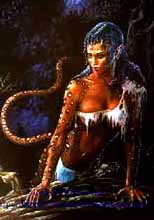 The Felines
The Felines
Scribed in the elven chronicles of lore in ancient times, it is first written of the sultry, vast jungles south of the elven nation and the discovery of a humanoid race with cat-like characteristics and abilities. Nestled in the secluded dense tropics, this graceful and sensual feline race flourished unhindered through time which is evident by their primitively elaborate villages found scattered throughout the jungles. Curious wooden statues in the likeness of the females of their kind can be found marking some village or tribes which may mean that they are clan/tribe territorial and possibly a matriarchal society which reveres the elder females of their race. Territorialism and a sense of encroachment by their animal-like counterparts, the Nykan and Lykan, may be a contributing factor to the past conflicts and wars that are shared by them. While war raged between them in times past, it has been hundreds of years since the last known conflict after which a truce was declared. This pact was made out of necessity for it is known now that these races have diminished in numbers and they tend to hold to each other in an effort to avoid extinction. It is also known that after this pact was made, more and more felines have been seen leading nomadic lives and even settling in villages out on the plains. Some have extended themselves even more and because of their grace, demeanor and intellect, have found themselves welcomed into the finer societies on Ateraan. Because of the harsh existance of the wilds the average lifespan of a feline is 85 years, but it has been known for those that dwell in cities to live longer. In common feline society a khit is considered an adult at 16 years of age. Averaging a height of 5 feet 4 inches and reaching an average weight of 130 lbs, felines are mostly humanoid in appearance but are noted for their common characteristic of fur which can vary uniquely from each individual. Whether long, short, thick, thin, sleek or scattered in patterns in natural hues of blond, brown, black or red, all take pride in their coat and often times will go to great lengths to groom it. Most have tails, although some are born without, and the majority of felines have cat-like ears which are positioned higher on the head than a normal cat. Large luminous eyes which are often referred to as the gateway to a felines soul are widely variant but are seen more in natural tones of golds, blues and greens. Proud and aloof, though very sensual and affectionate, curiosity is still a driving force for felines. Because of this driving curiosity most felines have been known to make decisions that were not wise nor intelligent. Although peaceful, felines are a proud race and their slim and quick bodies make them very agile combatants, though they are not known for their strength or fortitude. Graceful stealth, keen hearing and eyesight, distinct razor like canine teeth along with their honed claws with which all felines hold a natural skill, can make for a very formidable opponent. Its this same physiology that makes them the great hunters that they are and helps sustain their diet since all felines are carnivores. Fish, poultry and wild game seem to be the preferred food of felines. Felines have very distinct likes and dislikes that they show through indifference or even disdain to the races that disturb them. Elves are viewed as braggarts, nymphs as frivolous, dwarves as too avaricious and they have no tolerance for a gnomes pedantic ways. They show a superficial dislike of the lykos and nykos although the races have an unspoken closeness, each understanding how the other feels as an endangered people. They also are more tolerant of centaurs who they view as another hybrid race, which gives them some common ground. Because of their sheer size and strength, Trolahks are avoided by the more cautious felines among them. They distrust humans due to their reputed rashness and love of conquest but often find something mysteriously fascinating about them. While only conjecture on the part of lore historians, some believe that this race came about when a mountain lion was born with magical abilities and the power of intelligent thought. Some contribute this wondrous transformation to natural evolution while others maintain it was from stray magic during a powerful conflict between rival mages. Whether myth or fact, one may never know the advent of this mysterious and proud race now known to Ateraan as the Felines. |
 The Centaur
The Centaur
Out across Nordenland's vast Blue Ocean and surrounded by the Great Elemental Atoll, looms the magnificent land form known as Centaur Island. It is on this island, fed by the warm ocean winds with its lush rolling hills and fertile valleys, where the largest concentration of centaur make their home. Although secluded somewhat from the rest of the world, this small island nation is fabled to having the most prestigious and complete library on Ateraan and is known to be a worthy pilgrimage for scholars of all races. Looking upon the intricate marble spires of the Centaurian Lyceum and and the wealth of knowledge, lore and history that is held within its vast vaults, it is easy to admire the magnificent architectural skills and intelligence this noble race possesses. Centaur take great delight in the pursuit of knowledge and especially in the recording of history, being even more meticulous in keeping their chronicles than are the Elves. Centaur are a vital race of noble forbearance. Even though their origins are not known to the world and some only conjecture that they were brought into existence by some crazed magician in ancient times, many feel that the key to the Centaur origins is secreted away in the great Lyceum and this legacy is known only to Centaur themselves. Centaur are powerful, graceful, poised and balanced, combining the strength of an equine body with the arms, hands, reason, superior knowledge and emotion of a human mind. They are thought to be the perfect blending of the best properties of both human and equine aspects. Their equine body parts are usually cast in common horse colors and their hair most notably shaded in black or browns but have been known to run the full gamut of natural hue. Their eyes are within human ranges, though the vast majority of centaur have brown eyes. Majestic in appearance, a 25 year old adult centaur can average a height of 6 feet, 10 inches and weigh as much as 1900 pounds with an average life expectancy of 110 years. Because of their large equine frames, Centaur diet is very important to them and will tend to eat healthy vegetables and red meat in a conscious effort to nourish both their equine and human bodies. Centaur are fickle with most races and tend to only form close bonds with those of any race they deem as intelligent as themselves. They respect elves for their long history and shared passion of record keeping but they are largely indifferent to the Lykos and Felines whom they feel have few scholars among them. They tend to view nymphs as flighty and scatter brained and often time find them irritating. Traveling through Ateraan, one will find Centaur in almost any form of society or profession. Most, however, are found to be nomadic or cloistered within small clans and villages out on the open plains. Their fierce countenance, speed, agility and strength make them formidable warriors, their intellect and poised refinement make them a welcome addition to any noble society while even more follow the druidic path in life due to their deep respect for nature and the need to maintain the open lands which sustains them. |